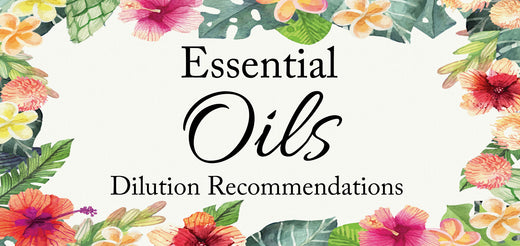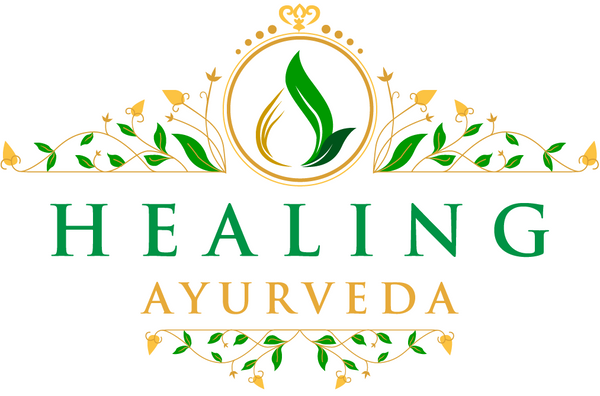
DILUTION GUIDANCE
Share

The left column represents carrier oil. For example, using 30ML of Jojoba oil as your base carrier oil to create a bath or massage oil for an adult the dilution rate can be 2 to 3% (12 -18 drops).
8 drops of Essential Oils in 1 ounce (30 ml) of carrier oil creates a 1% solution, it's common for a mix or a blend to be between a 1% and 3% solution.

These are general guideline suggestions. Information is based on traditional aromatherapy practice, not absolute rules. Percentage of Essential Oils to use will depend largely on the age of the person, health issue, oils being used, skin sensitivity and length of time to use.
(Source: Essential Oils usage and safety : Robert Tsserend, Julia Lawless)
Blending with more oils:
When blending more than one Essential Oils the number of drops in this chart represents the "total" amount.
1% dilution (1 drop Essential Oils per teaspoon of carrier oil; 5-6 drops per ounce) –This is also the dilution you want when you are massaging over a large area of the body.
2% dilution (2 drops per teaspoon of carrier oil; 10-12 drops per ounce) – ideal for most adults and in most situations. This is also a good dilution for daily skin care.
3% dilution (3 drops per teaspoon of carrier oil; 15-18 drops per ounce) – best used short-term for a temporary health issue, such as a muscle injury or respiratory congestion. Up to 10% dilution is fine, depending on the health concern, the age of the person, and the oils being used..
Using oils “neat” (undiluted) – Lavender, Neroli are few Essential Oils that can be used neat, on occasion, and only for short-term use. A bug bite, burn, or sting, might be a good reason to use Lavender neat. Just use caution when using undiluted, as some individuals can experience irritation or sensitivity when Essential Oils are used neat.
*Blending rates for children or the elderly use 1% dilution. Seek advice first from healthcare professional or licensed aroma therapist for any possible contraindications when blending for children or the elderly.

Indication: It takes between 1.2 and 1.5 pounds of Rose flowers to produce one drop of Rose Otto Essential Oils. So, 4 drops of Essential Oils per tablespoon of carrier oil (1% solution) is the equivalent of taking the essence from 6 pounds of roses and mixing them into 1 tablespoon of carrier oil.
To prevent any unexpected allergic reactions, we do suggest that you perform a skin patch test to check for any allergic reactions.
REFERENCE: For a more in-depth reference to Essential Oils, safety precautions and guideline, we recommend the following books:
- Essential Oils Safety: A Guide for Health Care Professionals, Written by Robert Tisserand and Tony Balacs, Churchill Livingstone.
- The Illustrated Encyclopedia of Essential Oils, written by Julia Lawless.

2.5% dilution = 15 drops of Essential Oils per ounce of carrier
3% dilution = 20 drops of Essential Oils per ounce of carrier
Facial Creams, Lotions And Oils
Adding Essential Oils to unscented/neutral facial creams or body lotions; add Essential Oils to create facial oil by using a variety of vegetable/herbal oils and then adding Essential Oils into the mix.
For adults:
Sensitive skin: .5 to 1 percent dilution = 3 to 6 drops per ounce
Normal, healthy skin: 1 to 2.5 percent dilution = 6 to 15 drops per ounce
Baths
Add 2 - 12 drops (depending on Essential Oils) into a teaspoon of honey, whole milk, vegetable oil or other dispersing agent then add to bath once you are in the bath.
Aromatic Spritzers
An aromatic spritzer is a combination of Essential Oils and water. Often a dispersant such as soluble is used to diffuse the Essential Oils within the water. Aromatic spritzers can be used as room fresheners, to cleanse the air, to uplift and energize, to scent space, or used during a massage or esthetical practice: e.g. sprayed on face cradles to keep respiratory passages clear.
Add 10-15 drops of Essential Oils (1-3 different Essential Oils) per ounce of water. Shake before using or add dispersing agent (e.g. soluble)
Diffusion
Depending on diffuser type, use as directed.
Steam Inhalation
Place 3-7 drops of Essential Oils into boiling water. Some Essential Oils to consider include: Eucalyptus sp. (either E. globulus or E. radiata), Thyme ct. linalol (Thymus vulgaris), Lemon (Citrus limon), and Tea tree (Melaleuca alternifolia). Cover head with towel and breathe through the nose. Keep eyes closed!

Place 3-7 drops of Essential Oils into boiling water. Some Essential Oils to consider include: Eucalyptus sp. (either E. globulus or E. radiata), Thyme ct. linalol (Thymus vulgaris), Lemon (Citrus limon), and Tea tree (Melaleuca alternifolia). Cover head with towel and breathe through the nose. Keep eyes closed!

This is a list of typical safety concerns when Essential Oils are used. Know these procedures so you can properly use and enjoy the Essential Oils.
Ingestion of Essential Oils orally:
Although the quality of our Essential Oils can be used internal and external, without proper understanding of safety concerns, we do not recommend such use. Although medical physicians and medical practitioners may administer Essential Oils for internal use, they are well qualified to apply Essential Oils safely.
Kurt Schnaubelt states that 1-2 drop is usually appropriate and can be placed in a capsule and filled with a Carrier Oil or mixed to honey, then drink with water. It helps to absorb and protect the tender endothelial membranes in the Essential Oils. Certain essential oils can be applied securely (diluted) around the Ear or used with a cotton ball in the Ear. Do not put Essential Oils into your Ears, Eyes & Nose.
Ingestion of Essential Oils orally accidentally:
Always keep the Essential Oils reach out of children, who does not understand and follow its strong properties and proper use. It is also necessary to safely store Essential Oils in a child-resistant container and to keep children out of reach.
Essential Oils are not safe to consume and can cause significant poisoning even if small amounts are ingested. Unless you're an expert or consulting with one, it's best to use Essential Oils only externally.Essential Oils are easily absorbed by mouth and the symptoms can grow 30 minutes after ingestion (some people experience symptoms delayed until 4 hours after exposure). The seriousness of toxicity depends on the type and amount of oil consumed.
Oil Dilution:
Skin is quite sensitive to Essential Oils with high subsequent concentration in phenols such as Anise, Basil, Birch, Cassia, Cinnamon Leaf & Bark, Lemon Grass, Cumin, Feneline, ct thymol. Dilute to prevent vulnerable areas like face and neck properly.
Essential Oils often always been diluted. Diluting Essential Oils appropriately expands the potential, generates a measure of protection and helps to resist discomfort, damage and sensitization. Since the life of carrier oils is minimal, consider diluting the quantities used in the life of the carrier oil. For plain, traditional guidance on dilution, refer to the corresponding dilution chart.
Skin Sensitivity Test:
Test a new oil / blend on a small area of the skin for those with sensitive skin to see how you react to it. Dilute adequately to prevent inflammation of the skin.
Skin Sensitivity Irritation:
Do not use Essential Oils on sensible molecular membranes like your skin, your nose and in any sensitive skin area. The effect of skin irritation or pain is diluted by a fatty oil (referred to as a carrier oil). Both lipophilic and hydrophobic oils are important. Lipophilic means that they are drawn to fat, such as the eye and skin membranes.
They're even hydrophobic, because water doesn't work well with them. Flushing water will only help the Essential Oils to get back to the skin or eye membranes which enhances the feeling of burning. Use a carrier oil to dilute the effect area, not water. The application of a carrier oil creates an additional fat to attract Essential Oils outside the membranes of the eyes.
UV Protection:
Prevent applying of undiluted photo-toxic oils to skin, which is exposed for direct sunlight or tanning beds (UV) for a span of at least 12 hours. Photo-toxic oils include: Angelica Root and Lima Limoon (expressed), Limoon Vervena and Limothy (expressed), Cumin Bitter Orange and Tagetes.
None photo-toxic Citrus Oils: Lemon distilled, Lime distilled, Orange Sweet, Mandarin Peel, Neroli, Petitgrain, Satsuma, Tangelo, Tangerine, Yuzu.

Below are general suggestions on Essential Oil dilution, not rules. The amount of EO use will mainly vary from person to person age, health condition, oils used, skin sensitivity and length of time. Size of the drop vary basis on Essential Oil and dropper type, so this is not an exact indicator.
During Pregnancy / Nursing:
Expecting / Nursing mothers, should study concerns in the use of Essential Oils or speak to a trustworthy Doctor. A baby in the womb has not been influenced by conventional usage of Essential Oil topically, or inhaled.
Infants / Kids:
When using Essential Oils for Babies, Infants & Children, use age-appropriate oils that are diluted as needed, as necessary. Keep Essential Oils out of the reach of Children and those with emotional disabilities. Do not add diluted oils to an infant or young child's face or next to them.
Be alert! Eucalyptus and Peppermint, 1,8-cineole and menthol can cause breathing issues.
For Baths:
If you choose essential oils to be used in bath water first pick a good Essential Oil, then apply liquid soap, milk or bath salts to a dispersant. This allows the oil to diffuse and keep blends from irritating delicate tissues.
Epilepsy:
Epilepsy or convulsive persons can examine how essential oils impact these disorders or seek a trustworthy health care provider. Lavandin, Sage, Wild Tansy (Vulgar Tanacetum) and Thuja are the ones which can be avoided. Birk and Fennel Hyssop (No problem HEO s decumbens variety) Ingested in moderate amounts of special essential oils (Burkhard et al 1989, Millet 1981) Seizures have occurred
-
Hyssop (2 doses of 10 drops) • Sage (1 dose of 12 drops) • Thuja (5 doses of 20 drops)
Blood Pressure control:
There is no persuasive proof for the exacerbation of hypertension or hypo-tension of Essential Oils.
Pharmaceutical Drug Interactions or Contraindications:
Follow the Pharmaceutical article provided.
Plastics:
Essential Oils dissolve / degrade some types of plastic, so they are not suitable to be used in plastic Styrofoam or drinking containers, humidifiers, CPAP masks and asthmatic nebulizers. Always use containers which are designed for Essential Oils use, made from glass, stainless steel or ceramic.
Click here to download the e-book

